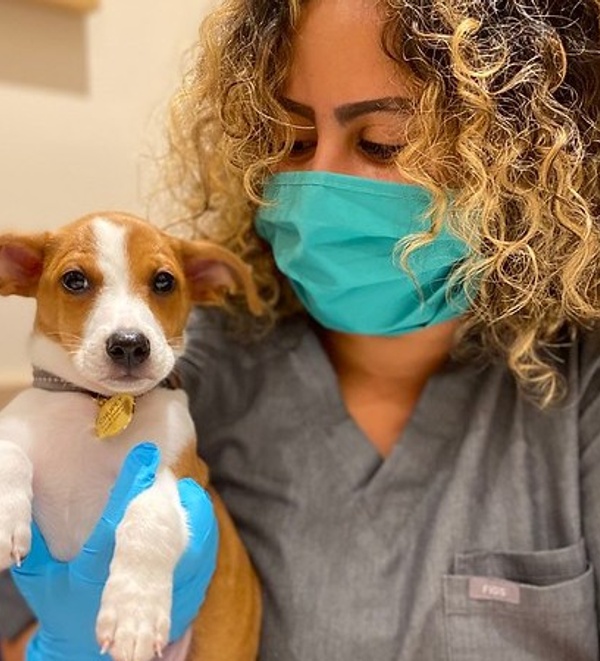
Patellar Luxation & Corrective Surgery for Dogs & Cats
Patellar luxation is a type of instability of the patella (kneecap), most commonly found in toy and small breed dogs. It’s much less common in big dogs or in cats, although occasionally it can happen in these pets.
Normally, the patella, which is part of the stifle joint (knee), sits in a groove between two ridges. But with patellar luxation, the patella can slide sideways outside of its normal position and out of its groove.
This makes it more difficult to place weight on the limb, especially if the condition is severe.
Luxating patella may or may not be painful in the short-term, but over time the joint instability often leads to the development of painful arthritis, and may put your pet at risk of other injuries such as a cranial cruciate ligament (also known as ACL) tear.
What are the symptoms of a luxating patella?
The most common clinical signs of a luxating patella include:
- Your pet “kicking” the joint back into place during physical activity. For example, if your pet is walking or running and they suddenly kick their leg out behind them, they might be trying to get their patella back to normal alignment.
- Limping, lameness, or holding a hindlimb up while walking or running — especially if your pup suddenly goes back to using all four legs, as if nothing happened.
- One or both back legs at an abnormal angle, which may look like a bowlegged or “crab-like” walk.
What are the causes of patellar luxation?
Most commonly, this is a genetic condition. Small and toy breed dogs, like Chihuahuas, Pomeranians, Toy Poodles, Yorkshire Terriers, and Maltese dogs, are most likely to be affected, and the condition may be detected by your veterinarian as early as your dog’s first puppy visit.
Can patellar luxation be prevented?
Most pets who have patellar luxation are born with it, so it’s not possible to prevent the condition.
However, the condition may worsen over time, and lead to the development of arthritis in the patella at a younger than average age. So, preventive measures are focused on joint health and stabilization.
Can supplements help?
To keep the joint as healthy as possible, use a good quality supplement such as glucosamine and chondroitin (ask your vet for their recommendation), and keep your pup at a healthy weight — obesity can put excessive pressure on an already unstable joint.
How is patellar luxation diagnosed?
Usually, patellar luxation is something your veterinarian can diagnose based on their physical examination — unless your dog’s muscles are tight, making it difficult to feel for the condition.
In fact, sometimes this diagnosis will be made at a new puppy visit, before a dog is showing any obvious symptoms.
Your home observations can also be very helpful. Capture any abnormal walking on video; this may assist your vet in making a diagnosis, since pets don’t always show their symptoms during a veterinary visit.
X-rays might not be needed for this diagnosis, but they may still be recommended to rule out concurrent conditions, especially if you are considering surgery.
For some pets, surgery may be a good option to stabilize the knee joint.
When is surgery for a luxating patella needed?
Some pets tolerate a luxating patella their whole life without too much of an issue, especially if it’s mild, which may be relieved with massage.
Surgery may be recommended for other pets, especially those with severe disease and lameness — based on the grading scale below, as well as on how your pet is doing and whether the condition is impacting their quality of life.
Patellar luxation is classified on a scale from less severe to more severe, based on your vet’s palpation of your pet’s knees:
- Grade I: The kneecap can be moved out of the groove with pressure, but normally stays in place.
- Grade II: The kneecap luxates (pops out of the groove) on its own sometimes, but spends most of the time in place.
- Grade III: The kneecap is mostly out of the groove, but can be placed back in the groove with pressure.
- Grade IV: The kneecap is entirely and permanently out of the groove, and can’t be pushed back into place at all.
Patellar luxation may exist in just one knee, or both. And, the condition may differ in severity in each leg.
LEARN MORE ABOUT SURGERY AT BOND VET
What does surgery entail?
The specific style and complexity of the surgery may vary depending on your pet’s needs. But, in any case, surgery involves stabilizing the joint so the patella can’t slide around. This can improve your pet’s mobility and help slow the development of arthritis.
For the surgery, you’ll need to fast your pet the night before. Then, our surgeon will perform the surgery and keep your pet under observation afterward.
Your veterinary surgeon may recommend keeping your pet in the hospital for 1-2 days, for intravenous pain meds, monitoring, and restricted activity so they can heal. But, this recommendation will vary by individual pet.
What does recovery look like?
When your pet comes home, they’ll probably receive:
- Pet-safe medications for pain and inflammation.
- An Elizabethan collar to prevent licking and chewing of the incision site.
- A bandage over the leg.
Usually, the most difficult part of recovery is encouraging your pet to rest. Too much physical activity too quickly can have a negative impact on healing, so it’s important that you restrict their movement.
Your pet’s instructions may vary, so always follow your vet’s instructions exactly, and call your vet with any questions or concerns.